
Les bruits anthropiques ont-ils une incidence sur l’acoustique des baleines de l’Arctique?
– Par Kimberly Franklin –
Le réchauffement de l’Arctique et la diminution de la couverture de la glace de mer multiplient les possibilités d’activités humaines telles que le transport maritime, la pêche et les exercices militaires dans le nord du Canada (p. ex. Mudryk et coll. 2021). Ces activités contribuent à augmenter les niveaux de bruit et à modifier le paysage sonore sous-marin de l’Arctique (p. ex. Stafford 2021, Cook et coll. 2022). Les mammifères marins s’appuient sur leur système auditif spécialisé pour détecter leur environnement et accomplir des fonctions vitales essentielles telles que la recherche de nourriture, l’accouplement et la navigation (p. ex. Hanke et coll. 2013). L’audition chez les baleines, les dauphins et les marsouins (cétacés) est vaste et diversifiée. Les baleines à dents sont généralement bien étudiées grâce aux recherches menées sur des espèces captives telles que les grands dauphins, mais on en sait beaucoup moins sur les baleines à fanons (Southall et coll. 2019). Les cétacés sont donc très sensibles au bruit des activités humaines, car leur répertoire vocal et leurs capacités auditives supposées tendent à se superposer aux zones de bruit de ces activités humaines.
La façon dont les mammifères marins de l’Arctique réagissent au bruit n’est pas bien connue (Halliday et coll. 2020). Pour combler cette lacune, un vaste projet lancé par ArcticNet et Recherche et développement pour la défense Canada, dirigé par Sarah Fortune (Université Dalhousie), étudie les impacts comportementaux et énergétiques des perturbations anthropogéniques sur les baleines de l’Arctique. L’un des objectifs de ce projet est d’examiner l’incidence des signaux des sonars militaires et du bruit des navires sur le comportement acoustique des baleines de l’Arctique. En particulier, les baleines à bec communes et les cachalots, qui sont des visiteurs estivaux relativement nouveaux dans la baie de Baffin et qui sont sensibles au bruit, notamment aux signaux des sonars. Nous cherchons à comprendre si ces espèces ont une réponse acoustique au bruit des sonars et des navires (p. ex. changements dans la fréquence des clics d’écholocation, changements dans les intervalles entre les clics) et, le cas échéant, quels facteurs de bruit ont contribué à la réponse acoustique (p. ex. durée, fréquence, niveau de pression acoustique) et quels comportements ont été interrompus (chasse, déprédation, etc.).
Pour répondre à nos questions, une série d’expériences de lecture a été menée dans la baie de Baffin, au Canada, autour de navires de pêche actifs à l’automne 2022 et prévues pour l’automne 2023. Cet endroit a été choisi parce que les baleines sont connues pour exploiter de manière fiable la pêche au flétan noir en se nourrissant des rejets de la pêche (Johnson et coll. 2021). Les expériences de lecture ont consisté à déployer divers enregistreurs de données acoustiques pour enregistrer l’activité de base (c.-à-d. les bruits naturels non perturbés et le comportement acoustique des baleines) avant l’expérience, ainsi que pour capter les enregistrements de lecture et tous les clics d’écholocation des baleines à bec communes et des cachalots produits au cours del’expérience. L’un des types d’enregistreurs de données que nous avons utilisés est une balise d’enregistrement acoustique numérique (DTAG) qui contient un enregistreur de temps et de profondeur, un accéléromètre 3D, un magnétomètre et un hydrophone (figure 2). Les DTAG se fixent par ventouse sur le dos des baleines pendant environ trois à quatre heures. Un autre enregistreur de données acoustiques que nous avons utilisé était un SoundTrap, qui était attaché à une bouée libre à la dérive avec un HighFlyer, une unité GPS et un émetteur satellite pour assurer la récupération (figure 3). Le dernier enregistreur acoustique était un planeur Slocum, un véhicule sous-marin autonome équipé d’un hydrophone, d’un GPS et d’autres capteurs océanographiques. Le planeur a été déployé dans la région une à deux semaines avant les expériences. Après le déploiement des DTAG et du SoundTrap pendant au moins une heure, un hautparleur sous-marin a été déployé pour diffuser les enregistrements audio d’intérêt pendant 20 minutes (figures 4 et 5). Les enregistrements audio consistaient en un son de contrôle (bruits ambiants précédemment enregistrés dans la zone), en un bruit de navire ou en un bruit de navire accompagné de signaux sonar. Après les enregistrements, les réponses de la baleine ont été contrôlées et enregistrées pendant au moins une heure. Une fois les expériences terminées, le haut-parleur et les enregistreurs (DTAG et SoundTrap) ont été récupérés et les enregistrements audio ont été téléchargés. Les enregistrements audio recueillis seront traités pour détecter les clics d’écholocation au moyen d’un détecteur et en annotant manuellement les données. Les clics seront analysés en fonction d’une série de paramètres, notamment les intervalles, les fréquences et les amplitudes des clics. Les niveaux sonores du bruit reçu des DTAG seront déterminés et comparés à un modèle de propagation sonore des bruits de lecture afin de comprendre comment les baleines ont reçu le bruit. Pour comparer les caractéristiques acoustiques du bruit du navire et des signaux sonar aux paramètres des clics détectés pour chaque type d’enregistrement, des modèles statiques tels que des modèles linéaires généralisés et/ou des modèles additifs généralisés seront utilisés. Ces résultats seront utilisés pour déterminer des seuils de bruit spécifiques pour les réponses acoustiques et, en fin de compte, comportementales.
– By Kimberly Franklin –
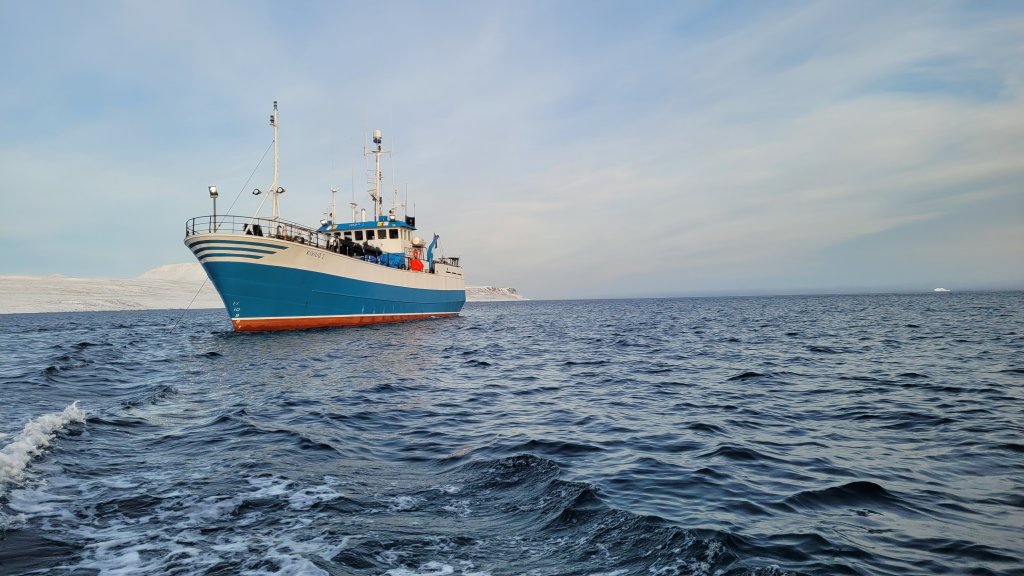
More opportunities for human activities such as shipping, fishing, and military exercises are arising in Northern Canada as the Arctic warms and sea ice coverage decreases (e.g., Mudryk et al. 2021). These activities contribute to increasing noise levels and changes in the Arctic underwater soundscape (e.g., Stafford 2021, Cook et al. 2022). Marine mammals rely on their specialized auditory system to sense their environment and perform essential life functions like foraging, mating, and navigating (e.g., Hanke et al. 2013). Hearing in whales, dolphins, and porpoises (cetaceans) is vast and diverse. Toothed whales are generally well studied due to research on captive species such as bottlenose dolphins, but considerably less is known about baleen whales (Southall et al. 2019). Thus, cetaceans are quite susceptible to noise from human activities as their vocal repertoire and assumed hearing ranges tend to overlap with the noise ranges of these human activities.
The effects of noise on marine mammals varies greatly in severity. Less severe effects include temporary disruptions to normal life functions and masking (e.g., Shrope 2002, Foote et al. 2004, Southall et al. 2019). Masking is when the environment is so loud it drowns out softer sounds at the same frequencies. More severe effects include temporary and permanent changes in hearing, short- and long-term stress, and even death. Exposed individuals typically exhibit avoidance behaviours such as swimming away, as well as changing their behaviour like ceasing foraging (e.g., Erbe et al. 2019). Acoustic behaviour can also be affected by increasing, decreasing, or ceasing vocalizations and/or echolocation clicks (e.g., Scheifele et al. 2005, Denise et al. 2012, Stainstreet et al. 2022). Echolocation clicks are click like sounds produced by toothed whales to scan their environment and detect prey. Typically, a combination these behaviours are identified, but responses vary by species, environment, the animal’s previous experiences, and the original behaviour the animal was engaged in (Miller et al. 2012).
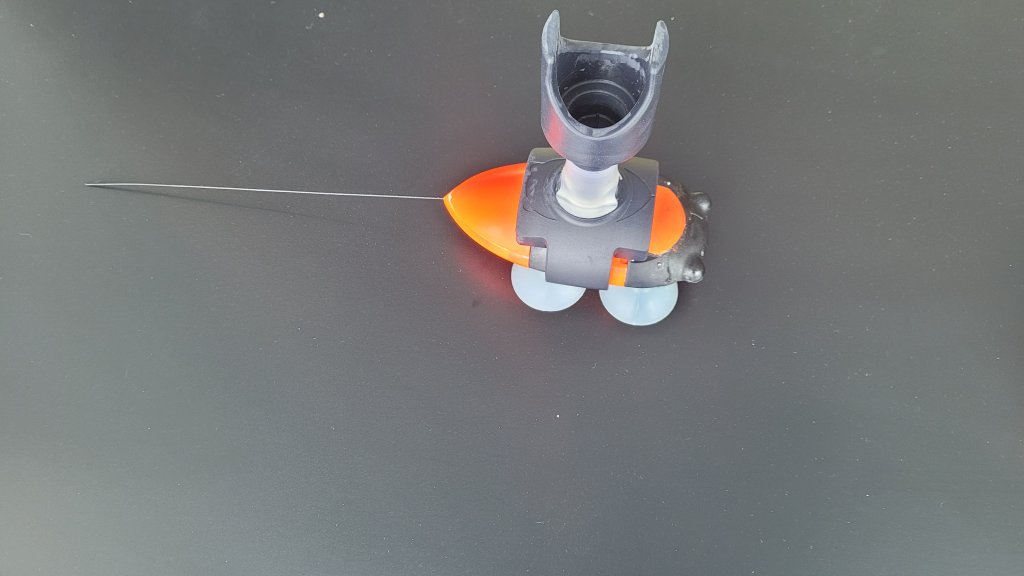
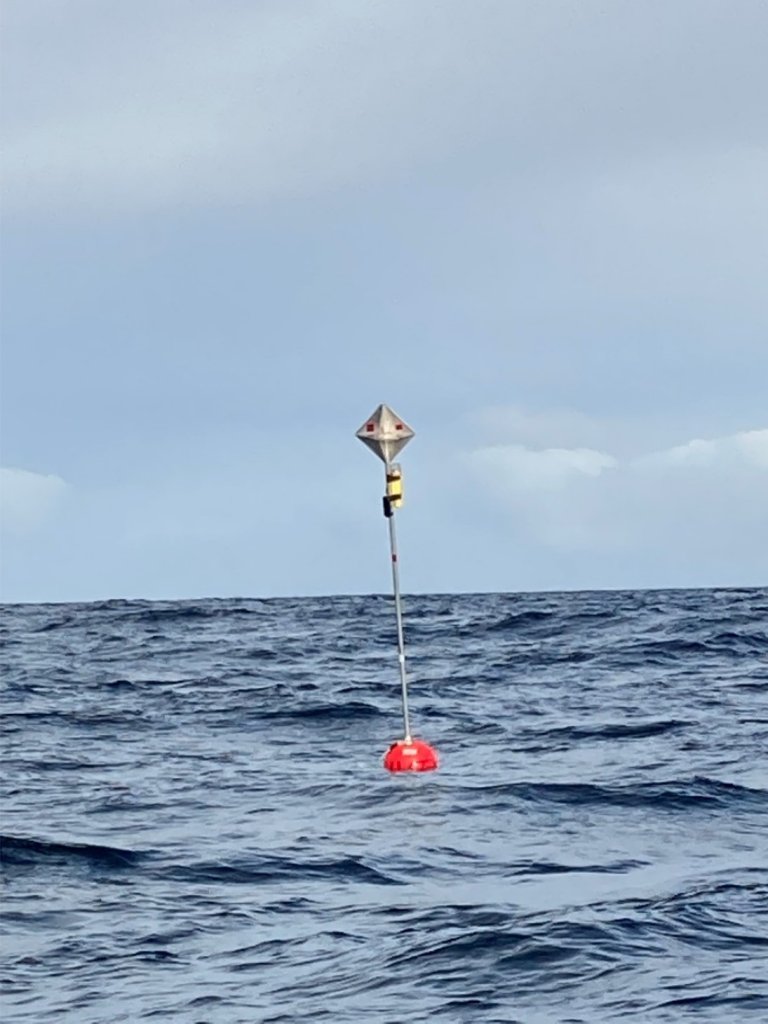
How Arctic marine mammals react to noise is not well known (Halliday et al. 2020). To fill this knowledge gap, a large project launched by ArcticNet and Defence Research and Development Canada, led by Dr. Sarah Fortune (Dalhousie University), is investigating the behavioural and energetic impacts of anthropogenic disturbance on Arctic whales. One objective of this project is to examine the impacts of military sonar signals and vessel noise on Arctic whales’ acoustic behaviour. Specifically, northern bottlenose whales and sperm whales as they are relatively new summer visitors to Baffin Bay and are sensitive to noise, especially sonar signals. We are interested in understanding if these species have an acoustical response to sonar and vessel noise (e.g., changes in echolocation click frequency, changes in click intervals), and if so, what noise factors contributed to the acoustical response (e.g., duration, frequency, sound pressure level) and what behaviours were interrupted (hunting, depredation, etc.).
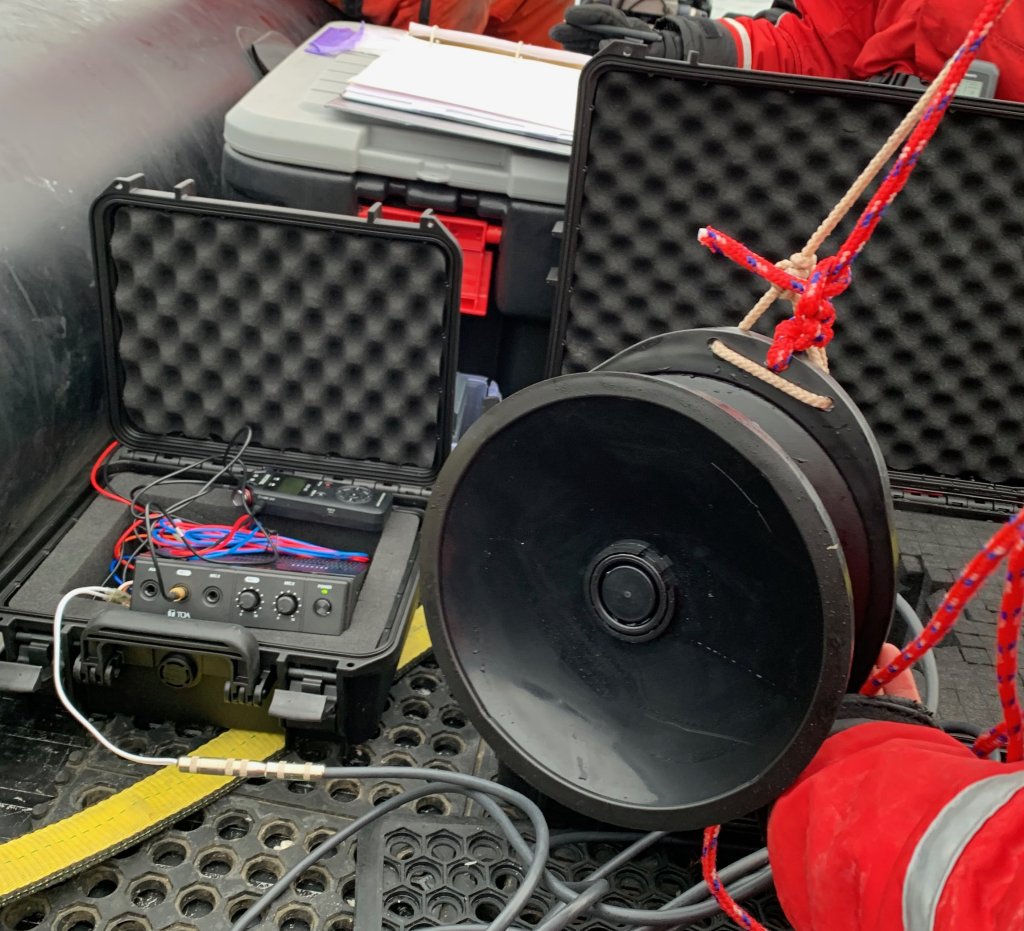
To answer our questions, a series of playback experiments were conducted in Baffin Bay, Canada, around active fishing vessels in the fall of 2022 and scheduled for the fall of 2023. This location was chosen because the whales are known to reliably exploit the Greenland Halibut fishery by foraging on the fishery’s discards (Johnson et al. 2021). The playback experiments consisted of deploying various acoustic data loggers to record baseline activity (i.e., undisturbed, natural noises and whale acoustic behaviour) before the experiment as well as capture the playback recordings and any northern bottlenose and sperm whale echolocation clicks produced during the experiment. One type of data logger we used was a digital acoustic recording tag (DTAG) which contains a time-depth recorder, 3D accelerometer, magnetometer, and hydrophone (Figure 2). The DTAGs attach, via suction cup, to the whales’ backs for approximately three to four hours. Another acoustic data logger we used was a SoundTrap, which was attached to a free drifting buoy with a high-flyer, GPS unit, and satellite transmitter to ensure recovery (Figure 3). The last acoustic logger was a Slocum glider, which is an autonomous underwater vehicle equipped with a hydrophone, GPS, and other oceanographic sensors. The glider was deployed in the region one to two weeks in advance of the experiments. After the DTAGs and SoundTrap were deployed for a minimum of an hour, an underwater speaker was deployed to play the audio recordings of interest for 20 minutes (Figures 4 and 5). The audio recordings consisted of a control sound (ambient noises previously recorded from the area), vessel noise, or vessel noise with sonar signals. After the playbacks, the whale’s responses were monitored and logged for a minimum of 1 hour. Once the experiments were concluded the speaker and the loggers (i.e., DTAGs and SoundTrap) were recovered and the audio recordings were downloaded. The collected audio recordings will be processed for echolocation clicks using a detector and by manually annotating the data. The clicks will be analyzed for a suite of parameters including, click intervals, frequencies, and amplitudes. The received noise sound levels from the DTAGs will be determined and compared to a sound propagation model of the playback noises to understand how the whales received the noise. To compare the acoustic characteristics of the vessel noise and sonar signals to the parameters of the detected clicks for each playback recording type, statical models such as generalized linear models and/or generalized additive models will be used. These findings will be used to determine specific noise thresholds for acoustical, and ultimately, behavioural responses.
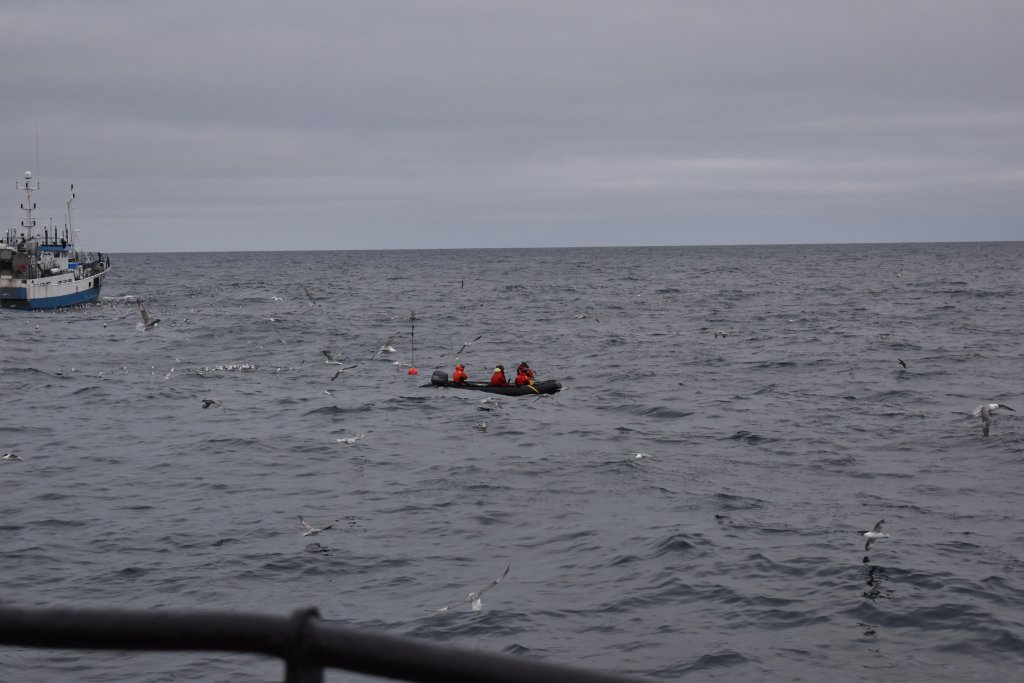
A working understanding of whale behaviour and underwater sound levels in the Arctic can aid in the implementation of well-informed proactive measures. Opposed to employing strong reactive measures later in time, such as those for whales that inhabit urban environments, like the North Atlantic right whale. This work aims to be proactive by determining acoustic behavioural responses and thresholds from military sonar and vessel noise before these noise sources become pervasive. Our research is conducted under a unique circumstance such that the impacts from noise will be investigated in a busy/noisy environment where active fishing is occurring, and the whales are engaged in depredation and fishery discards. This can be interpreted to artificially reflect responses that may occur while the animals are engaged in a natural high rewarding life function activity (e.g., hunting) while human generated noises are present. Thus, the findings from this work will aid in supporting risk mitigation strategies, legislation, and policy plans for the Department of National Defence Canada (DND) and Fisheries and Oceans Canada (DFO) as these agencies seek to prevent excessive and unnecessary noise for current and future populations of marine mammals in the Arctic. Our research aligns with Indigenous communities’ concerns about increased military noise levels on Arctic whale species and provide opportunities to work with them. Overall, this work will support conservation and protection efforts for Arctic whales about the impacts of anthropogenic noise and contribute to understanding these species acoustic ecology.
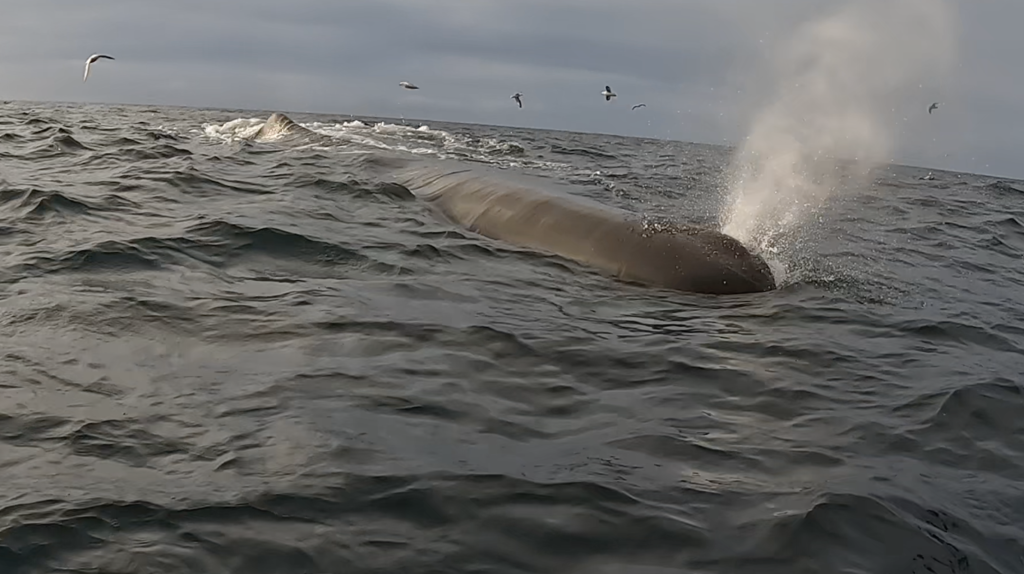
Kimberly Franklin is a Master of Science student in Oceanography at Dalhousie University. She completed her undergraduate degree in marine biology and math with an honours project that introduced her to right whale acoustics. Ever since she’s been interested in using whale vocalizations to decipher their behaviour. She enjoys learning and working with ocean technology and sharpening her whale identification skills, both visually as a Marine Mammal Observer and auditorily as a PAM Operator.
References
Cook ED, Barclay DR, Richards CG. 2022. Real-time acoustic observations in the Canadian Arctic Archipelago. J Acoust Soc Am. 151(3):1697-1614. https://doi.org/10.1121/10.0009678
Denise R, Corkeron PJ, Ellison WT, Van Parijs SM. 2012. Changes in humpback whale song occurrence in response to an acoustic source 200 km away. PLoS One. 7(1):e29741. DOI: 10.1371/journal.pone.0029741
Erbe C, Marley SA, Schoeman RP, Smith JN, Trigg LE, Embling CB. 2019. The effects of ship noise on marine mammals—A Review. Front Mar Sci. 6:606. https://doi.org/10.3389/fmars.2019.00606
Foote AD, Osborne RW, Hoelzel AR. 2004. Whale-call response to masking boat noise. Nature. 428(6986):910. https://doi.org/10.1038/428910a
Halliday WD, Pine MK, Insley SJ. 2020. Underwater noise and Arctic marine mammals: review and policy recommendations. Environ Rev. 28(4):438–448. https://doi.org/10.1139/er-2019-0033
Hanke W, Dehnhardt G. 2013. Sensory biology of aquatic mammals. J Comp Physiol A. 199(6):417–420. https://doi.org/10.1007/s00359-013-0823-9
Johnson KF, Hussey NE, Ferguson SH. 2021. Observation of marine mammal and bird interactions focused around a commercial fishing vessel in central Baffin Bay, Nunavut. Arct Sci. 7(2): 567–574. https://doi.org/10.1139/as-2020-0014
Miller PJO, Kvadsheim PH, Lam FPA, Wensveen PJ, Antunes R, Alves AC, Visser F, Kleivane L, Tyack PL, Sivle LD. 2012. The severity of behavioral changes observed during experimental exposures of killer (Orcinus orca), long-finned pilot (Globicephala melas), and sperm (Physeter macrocephalus) whales to naval sonar. Aquat Mamm. 38(4):362-401. DOI: 10.1578/AM.38.4.2012.362
Mudryk LR, Dawson J, Howell SEL, Derksen C, Zagon TA, Brady M. 2021. Impact of 1, 2 and 4 °C of global warming on ship navigation in the Canadian Arctic. Nat Clim Chang. 11(8):673–679. https://doi.org/10.1038/s41558-021-01087-6
Scheifele PM, Andrew S, Cooper RA, Darre M. 2005. Indication of a Lombard vocal response in the St. Lawrence River beluga. J Acoust Soc Am. 117(3):1486-1492. https://doi.org/10.1121/1.1835508
Shrope M. 2002. Whale deaths caused by US Navy’s sonar. Nature. 415(6868):106. DOI: 10.1038/415106a
Southall BL, Finneran JJ, Reichmuth C, Nachtigall PE, Ketten DR, Bowles AE, Ellison WT,
Nowacek DP, Tyack PL. 2019. Marine mammal noise exposure criteria: updated scientific recommendations for residual hearing effects. Aquat Mamm. 45(2):125-232. DOI: 10.1578/AM.45.2.2019.125
Stafford K. 2021. The changing Arctic marine soundscape. NOAA Technical Report OAR ARC; 21-14. https://doi.org/10.25923/jagc-4a84
Stanistreet JE, Beslin WAM, Kowarski K, Martin SB, Westell1 A, Moors‑Murphy HB. 2022. Changes in the acoustic activity of beaked whales and sperm whales recorded during a naval training exercise off eastern Canada. Sci Rep. 12(1):1973. https://doi.org/10.1038/s41598-022-05930-4
Arctique, baffin, baleine, dalhousie, kimberly franklin, l’acoustique